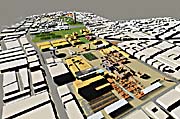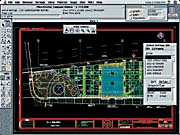| CAD SYSTEMS | May '97 |
At Moriyama & Teshima we have become one of the largest users of the Apple Macintosh computer in the Architectural industry. We now have over 20 Macintoshs of all descriptions connected together on an Ethernet network. Both partners, Raymond Moriyama and Ted Teshima, have PowerBooks and use them every day. Only a couple of drafting boards remain in our office for occasional use. Apart from design sketches and some early conceptual drawings and physical models, most architectural design work is done using the computer. Often times our drawn sketches are scanned so we can manipulate them on the computer and include them in reports and presentations.
Our philosophy is to put a complete set of tools into the hands of everyone on our staff to effectively complete all the varied tasks that an architect is required to do. We draw and design buildings using the Macintosh computer but that is only the start. At M&T we have do not have designated 'computer people' and certainly no 'CAD Department'.
We re-trained our existing staff instead of bringing in computer aces. Architectural knowledge and experience are still the top priorities over computer skills which can be added later. The consistent Mac interface from one program to another aids in this. Work in the office is not forced onto the computer. We are always examining the appropriateness of everything we do using computers.
In 1988 we bought our first Macintosh II computer and FileMaker software to produce a database of furniture for the Ottawa-Carleton Centre, a regional headquarters building. Over time we acquired more software: Quark Xpress, Adobe Illustrator, MacWrite and MacDraw. CAD was still being done using GDS software with Digital hardware, the CAD system we started to use in 1987 primarily for 2-D working drawings. The only CAD packages available for the Mac at this time were not yet powerful enough for us to consider.
It was interesting to see how this first Mac was used. Placed in a central location, rather than at someone's specific work place, it was soon being used by all sorts of different people. The first time I saw the Mac graphic interface I knew this was how a computer should work. Our architects and designers, very visually oriented people, agreed and took to it immediately. There certainly was no such lineup at our IBM PC to input commands. In fact, over the years, a number of people have joined the firm who were not previously Macintosh users. At first, they questioned its use, but many have now sold their PCs and switched to Macintosh. Windows may have caught on since, but it still has not approached the elegance of the MacOS. Only Mac users seem to appreciate this. With the integration of Next computer technology into the future generations of the MacOS, it can only get better.
When AutoCAD R10 was released for the Macintosh in 1991 we purchased one copy to try it out. One of our clients required that we supply disks of plans and reflected ceiling plans to in Autocad format at the end of the project. Since only a couple of people here really knew AutoCAD we actually debated doing the working drawings by hand and re-drawing them later in AutoCAD. Another suggestion was drawing them in GDS and then translating to AutoCAD later. We tried some tests, but results were disappointing. We plunged ahead, arranged some AutoCAD training and started to draw, not necessarily in that order. Some of our people who knew GDS picked up AutoCAD quite readily. We then purchased another copy of Autocad and another computer. And so on.

We were also one of the first users of Alias Upfront, using it for massing models and shade and shadow studies. The user interface, where you actually worked in a full 3-D environment, was something new for a desktop machine in 1991. It was Mac only, and better still, a Canadian product.
When AutoCAD R11 and, later, R12 were released, we upgraded. It was not until R12 that the software really came into its own. Now the Windows and Macintosh versions were almost identical.
We produced some 3-D models of the Bata Shoe Museum in AutoCAD but found the interface left something to be desired. It was not very 'architectural' in nature. Add-on packages gave the program an architectural framework for us to work in, but we did not find any one of these add-ons totally satisfactory.
We needed a program that would allow our project architects and designers to create in 3-D themselves. If you have to sketch something by hand and pass it on to your '3-D CAD person' to model, then you have missed CAD opportunities for exploring new ideas.
In 1993 we looked at Archicad and Architrion for their 3-D capabilities. Both took full advantage of the Macintosh graphical user interface. Archicad combined 2-D and 3-D drawings in the same workspace, and everything done on the 2-D model was reflected in the 3-D views. Architrion had separate modules for 2-D and 3-D. After many demos and hands-on tests by our designers, Architrion was selected for its three dimensional capabilities of that worked better for our people.
In early projects we started with 2-D base plans, brought them into the 3-D module of Architrion and modelled on top of them as you might expect. Then another approach evolved. The major volumes were blocked out creating essentially a 3-D space relationship diagram. These models were then sculpted into architectural spaces and thus a building.

Early in 1995, as the DOS and Windows users were starting to switch to R13 of AutoCAD, Mac users kept asking when their upgrade would be released. The answer turned out to be "never". This also meant no PowerPC version. AutoCAD would have to be run with using an '040' processor only.
About this time, we needed some more new computers. Would we stick with the Mac or be forced into the PC world? There are so many non-CAD things that we prefer on the Mac platform, that after evaluating all the variables we decided to stay with Macintosh and see what the future would hold.
We acquired our first copy of Microstation 3 1/2 years ago, and it has become our 2-D software of choice. It is supported on just about every platform, files are compatible across all of them. Microstation is fast and handles large files with ease. Many larger New York and Chicago-based architectural and engineering firms use Microstation, as do many European firms. In the Toronto area, the TTC (Toronto Transit Commission) and Metro Toronto are managing our subways and roads respectively using Microstation. Nobody in our office who has mastered Microstation would go back to Autocad now.
Until recently being a Macintosh office meant buying Apple only products. We now have some Power Computing clones and they are fast and reliable. Using the PowerFPU 68K FPU emulator we can run AutoCAD R12 even faster than on a Quadra 650 or 800 if we wish. If necessary, we could install an expansion card with a Pentium chip in our Macs to run a newer Windows version of Autocad, but we prefer not to. Microstation and Architrion, already fast on Quadra level machines, really fly on the PowerPC equipped machines.
Apart from software and hardware, one of the most important investments we have made is in establishing mandatory office standards for CAD. They may change and evolve over time, but we will all be working to the same consistent standard. We publish these rules in our Computer Handbook, which has been distributed to each member of the staff. It describes how to start a project, how to name files and folders, and provides layer/level tables. The handbook also covers how to plot either in-house or with an outside printer. The underlying objective is to get to the architectural work as soon as possible and have predictable results. Anyone can work on someone else's drawings and expect consistent behaviour.
Our handbook covers not only CAD but all the documents we produce. This covers our main software packages, WordPerfect (for minutes of meetings, letters, transmittals faxes etc.), FileMaker Pro (for client databases and for door and room finish schedules), FastTrack Schedule (project time scheduling) and ClarisWorks (for spreadsheets and other miscellaneous documents).
Apple is strong in publishing and graphic design. We also use the Macintosh system for graphic design, desktop publishing, and preparation of presentations using Quark Xpress, Adobe Illustrator and Adobe Photoshop. All our promotional material is produced in our office except for some of the final colour output. We now have a CalComp TechJet colour inkjet plotter for in-house plotting and large format postscript printing. The plotter and one of our modems are networked devices accessible from every computer.

Those of you who share CAD files with others, have probably been through this scenario. The structural engineer needs new background plans and calls you up with a list of the files. You have to gather all the files together, put them on disk, write a transmittal and arrange for a courier. They may get there the next day if you are not too busy. This can occur many times throughout the project.
We do it another way. Using First Class bulletin board software from SoftArc, a Canadian company, we created our own service, M&T Online. When we backup our drawings into the server at the end of each day, they become available to our consultants. The First Class Server, running on one of our old Macintosh II computers, allows us to control access and make available only the drawings we want others to use. The engineers can log in any time and download our latest files or send us their latest drawings. This has worked particularly well for clients and consultants as far away as Vancouver, B.C. or Bath, U.K.
All the Macintosh computers we have bought over the last few years are still in use. What was once our most powerful CAD machine may now be used for word processing, accessing a database or research on the Internet. The hardware has always been easy to set up and seems to require less support than most PCs and they have always been easy to configure on a network.
For a recent international design competition, we produced 3-D models in Architrion and Microstation that were combined together, rendered, and animated with Electric Image software on a Mac. The final fly-through with sound, narrative and additional visual effects was transferred to videotape and presented to the client. Our efforts were worthwhile. We won the competition. In the future this could be a VRML model that is available to view on the Internet or it could be a QuickTime movie that can be downloaded and view later.
As a architectural firm where design excellence is the goal, the Mac is helping us achieve more.
For more examples of what we do with CAD and computers, (sorry no VRML yet), visit us at www.mtarch.com.
Norman Jennings is an associate at Moriyama & Teshima architects, based in Toronto, ON, responsible for computer management.
